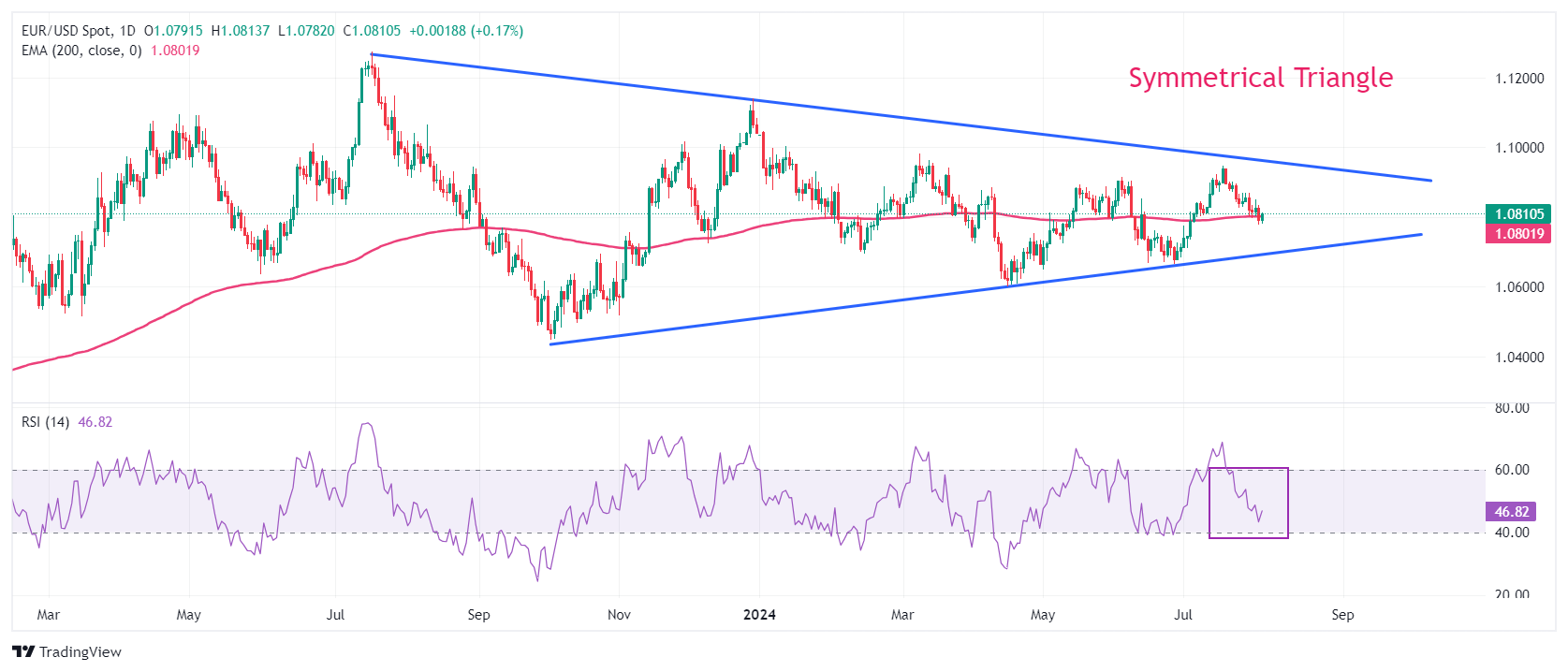EUR/USD Recovers Above 1.0800 As US Dollar Declines Ahead Of US NFP
EUR/USD hovers near the round-level figure of 1.0800 in Friday’s European session. The major currency pair is expected to remain on the sidelines as investors await the United States (US) Nonfarm Payrolls (NFP) data for July, which will be published at 12:30 GMT.
Economists estimate that 175K new workers were hired in July, lower than the former addition of 206K. The Unemployment Rate is expected to remain steady at 4.1%.
Investors will also focus on the Average Hourly Earnings data, a key measure of wage growth that fuels consumer spending and eventually influences price pressures. Annually, the wage growth measure is estimated to have decelerated to 3.7% from the prior reading of 3.9%, with the monthly figure growing steadily by 0.3%.
Ahead of the US NFP report, the US Dollar (USD) exhibits a subdued performance as a string of weak US economic data has pointed to a slowdown in the economy, which will add to reasons prompting the Federal Reserve (Fed) to begin reducing interest rates in September. The US Dollar Index (DXY), which tracks the Greenback’s value against six major currencies, drops to near 104.20.
On Thursday, the US ISM Manufacturing Purchasing Managers Index (PMI) report for July showed that factory activities unexpectedly contracted at a faster pace to 46.8. Economists estimated the Manufacturing PMI to contract at a slower pace to 48.8 from June’s reading of 48.5. Also, Initial Jobless Claims for the week ending July 26 came out highest in 11 months. Individuals claiming jobless benefits for the first time were higher at 249K than estimates of 236K and the former release of 235K.
Daily digest market movers: EUR/USD rises despite Euro remains on the backfoot
- EUR/USD edges higher to near the round-level resistance of 1.0800 in European trading hours on Friday. The performance of the shared currency pair has remained weak in the past few trading sessions. The asset fails to discover significant buying interest even though the Fed has leaned towards pivoting to policy normalization in September.
- On Wednesday, the Fed kept interest rates unchanged in the range of 5.25%-5.50% but delivered a dovish guidance, as expected. Fed Chair Jerome Powell said, "If we were to see inflation moving down more or less in line with expectations, growth remains reasonably strong, and the labor market remains consistent with current conditions, then I think a rate cut could be on the table at the September meeting”, Reuters reported.
- On the other side of the Atlantic, the Euro struggles to recover despite the hotter-than-expected Eurozone preliminary Harmonized Index of Consumer Prices (HICP) in July. The headline HICP unexpectedly rose to 2.6%, while economists expected the inflation figure to decelerate to 2.4% from June’s reading of 2.5%. The core HICP, which strips off volatile items such as food, energy, alcohol, and tobacco, grew steadily 2.9% against expectations of 2.8%.
- Also, the old continent’s preliminary Gross Domestic Product (GDP) growth in the second quarter was higher than expected. The Eurozone economy expanded steadily by 0.3%, while investors anticipated a slower growth rate of 0.2%.
- A scenario of stubborn inflation and steady growth is unfavorable for market expectations for interest rate cuts. Financial markets currently expect the European Central Bank (ECB) to cut its key borrowing rates two times more this year. A few ECB policymakers are comfortable with market expectations, while others refrain from committing to a specific rate-cut path.
Technical Analysis: EUR/USD hovers inside Symmetrical Triangle pattern
(Click on image to enlarge)
EUR/USD trades inside a Symmetrical Triangle formation on a daily timeframe, exhibiting a sideways trend. The aforementioned chart pattern signifies a sharp volatility contraction, which is expected to remain for a while amid the absence of clear signals of a breakout or a breakdown.
The shared currency pair faces selling pressure near the 20-day Exponential Moving Average (EMA) around 1.0835, suggesting that the near-term trend is bearish.
The 14-day Relative Strength Index (RSI) oscillates in the 40.00-60.00 range, indicating indecisiveness among market participants.
More By This Author:
USD/CAD Price Analysis: Retreats To 1.3800 As US Dollar Surrenders Intraday GainsEUR/USD Price Analysis: 20-Day EMA Acts As Key Barrier For Euro Bulls
Silver Price Tumbles To Near $28.70 As USs Dollar Recovers Ahead Of US Data
Disclaimer: Information on this article contains forward-looking statements that involve risks and uncertainties. Markets and instruments profiled on this page are for informational purposes ...
more



